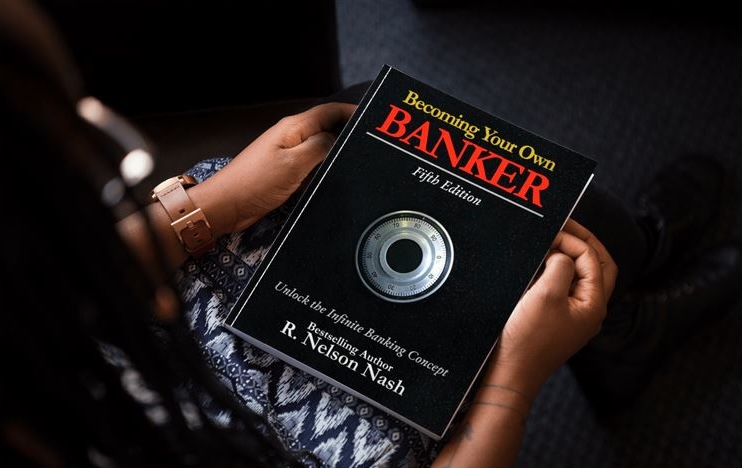Does Velocity Banking Work for Paying Off Debt Faster?
Fast isn’t always better. In their search for quick solutions to financial problems, many families are discovering a strategy called velocity banking. While it may offer a faster way to pay off debts, does it actually work, and is it sustainable in the long term?
Velocity banking uses your Home Equity Line of Credit (HELOC) to pay your debts, as it usually has a lower interest rate than other debts. By funnelling your paychecks into your HELOC, rather than your checking account, you pay down your principal faster. But this strategy is not without its risks and limitations.
In this article, we’ll explain how the velocity banking strategy works to transform debts into a different form, minimizing interest and stress, and compare it to the Infinite Banking Concept for managing debts and covering life’s expenses.
What Is Velocity Banking?
Velocity banking is a home equity line of credit strategy that uses your HELOC to save on loan interest and pay down your debt faster. Here’s how it works:
- Open a low-interest HELOC or other low-interest revolving line of credit. This account becomes your financial “hub.”
- Take a lump sum from your HELOC and use it to pay a portion of your mortgage. This reduces your mortgage interest rate over time, while you transfer the debt to a lower-interest account.
- Pay your regular bills directly from your HELOC, rather than your checking account.
- Deposit your paychecks into your HELOC to replenish the balance and pay off the amount owed.
As you lower your HELOC balance, you can take more chunks to pay down your mortgage and repeat the cycle.
Velocity Banking vs Infinite Banking
When considering strategies to pay down debts, many compare velocity banking and Infinite Banking. The short comparison is:
- Velocity banking uses borrowed credit to support debt repayment as a short or mid-term strategy.
- Infinite Banking is a long-term, holistic wealth management strategy that puts you in control of your finances, giving you greater overall financial freedom to pay off debts, cover larger expenses, and make investments.
While both can be effective debt payoff strategies, they’re different in their philosophies and approaches:
| Velocity Banking | Infinite Banking | |
| Goal | For accelerated debt payoff and saved interest | To build wealth and liquidity |
| Time | Short-mid term | Long term |
| Primary Tool | Home Equity Line of Credit (HELOC) | Whole life insurance policy with cash value |
| Interest Paid to… | The bank or financial institution | You, through your policy |
| Key Risks | Changing interest ratesOverspending can increase the debt load | If the loan is unpaid, your death benefit decreases. Policy can lapse if the loan is unpaid |
| Best for… | Those with a home, steady income, positive cash flow, and a disciplined budget | Those who want to build long-term, generational wealth and be in control of their money |
The risk of variable HELOC rates compared to the stability of Infinite Banking is like night and day. With a HELOC, you’re at the mercy of fluctuating interest rates. If rates go up (and let’s face it, they often do), you’re paying more interest, which can throw off your entire financial strategy. It’s unpredictable, and that lack of control can be stressful, especially if you’re relying on a velocity banking HELOC.
On the other hand, Infinite Banking is built on a dividend-paying whole life insurance policy. The cash value grows predictably, unaffected by market volatility or interest rate hikes. When you take out a policy loan, the insurance company charges a fixed or very stable rate, and your cash value continues to grow uninterrupted. That’s a huge advantage because it gives you control and peace of mind. You’re not at the mercy of external factors like rising rates or market swings.
A HELOC can be a valuable tool in certain situations, but it doesn’t offer the same level of stability and long-term financial control strategies that an Infinite Banking strategy does.
Take control of your financial future.
Schedule a consultation with Ascendant Financial and ensure your financial choices align with your long-term goals — before it’s too late.
Expert Advice: Understanding Velocity Banking vs Infinite Banking
When explaining the difference between Infinite Banking and velocity banking to a client, Ascendant Advisors focus on control, risk, and long-term benefits:
The Velocity banking strategy relies on tools like HELOCs, which are tied to variable interest rates and external lender terms. This means your strategy is at the mercy of market fluctuations, and any misstep, such as inconsistent cash flow, can derail your progress.
Infinite Banking, on the other hand, is built on a dividend-paying whole life insurance policy. It offers stable, predictable growth, and policy loans are unstructured, meaning the client controls repayment. Plus, the cash value grows uninterrupted, even when loans are taken out. It’s not just about paying off debt; it’s about recapturing that debt and building a lifelong asset that creates financial independence.
To help our clients clarify their priorities and choose between these two systems, our advisors typically ask: “Do you want to rely on a system you control or one controlled by external factors?”
Does Velocity Banking Actually Work?
Velocity banking isn’t right for everyone, but for those who qualify, it can reduce the interest paid over the lifetime of your mortgage or other large debt. Here are three things you need to succeed in velocity banking:
- A steady income. Your income should exceed your typical bills to avoid increasing your debt load.
- Strict financial discipline. With a large available credit, it’s often easy to keep adding to your debt load without the ability to pay it off.
- Education. Being aware of the risks (such as variable interest rates) is essential to ensure you use your velocity banking HELOC responsibly.
In comparison, Infinite Banking can achieve the same debt payoff results as velocity banking, but it does so with far more control and less risk. With velocity banking, you’re relying on a HELOC or line of credit, which introduces variable interest rates and the risk of overleveraging. Infinite Banking, on the other hand, uses a dividend-paying whole life insurance policy, allowing you to borrow against your cash value while it continues to grow uninterrupted.
Common Misconceptions About Velocity Banking
Like many financial strategies, velocity banking is often misunderstood by many families. Here are the top three misconceptions we hear about velocity banking:
- “It’s a shortcut to being mortgage-free.”
This is actually not true. Your debt is only transferred and remains in your HELOC until you repay it. The benefit is a savings in interest in this lower-interest account, but it is not necessarily a shortcut to becoming mortgage-free. - “It creates new money.”
Velocity banking doesn’t create new money. You simply transfer your money to a different loan account. Your cash flow is diverted, not increased. - “It’s risk-free.”
No financial strategy is without risks, especially velocity banking. A risk that sometimes takes people by surprise is variable interest rates. Interest rates may go up, affecting your ability to pay down the account.
Our Ascendant Advisors hear these misconceptions all the time. That’s why education is such a big part of what we do. We work with clients to dispel these misconceptions, enabling them to utilize banking systems like velocity banking and Infinite Banking without further entrenching themselves in debt.
Another mistake we see people making is mismanaging their line of credit. It’s tempting to use it for non-essential purchases, but that undermines the whole purpose of the strategy. That’s why it’s important to grasp the importance of consistent financial habits fully. Velocity banking isn’t a magic fix; it requires focus and commitment to see results.

Pros and Cons of Velocity Banking
To help you better understand the benefits and risks of velocity banking, we’ve prepared this quick-reference pros and cons list:
Pros:
- Can save on interest. Transferring your loan from a higher-interest account to a lower-interest one saves you interest owed over the lifetime of your loan.
- Can accelerate debt payoff. By depositing your paycheck into your HELOC, you pay more towards your principal, helping you pay off your loans faster and with lower interest.
- Greater awareness of spending habits. With all your income and expenses in one account, you can easily see your monthly spending habits.
Cons:
- Requires discipline to avoid overborrowing. With such “easy” access to credit through your HELOC, some may overborrow, leading to struggles to pay it off.
- Variable interest rates. Variable interest rates in HELOC accounts can make it difficult to budget effectively. If interest rates rise, some may struggle to make their minimum payments.
- Requires equity. This strategy relies on a low-interest line of credit account, such as a HELOC. If you don’t have enough equity in your home, your access to capital may not be enough to make this a helpful debt repayment strategy.
Ready to learn a better way? Discover how Infinite Banking can put you back in control of your money.
Ready to take control of your financial future?
Speak with an Ascendant Financial Advisor today and start building a strategy that protects your legacy.
Is Infinite Banking a Better Alternative?
Effective financial management requires understanding your accounts and control of your money. Infinite Banking is one strategy many Canadians and Americans are turning to for liquidity and generational wealth building.
Infinite banking uses a participating whole life insurance policy with cash value as collateral for low-interest loans. You can customize the interest rate and repayment terms to your needs and use the borrowed funds for any purpose, from paying down debts, making investments, or making large purchases (like vehicles or homes).
Infinite banking is popular for those who:
- Want control over their cash flow management
- Want to build generational wealth, keeping that money in the family
- Want greater liquidity to finance life’s purchases
- Can afford to pay policy premiums over their lifetime.
Infinite Banking creates a system where financial wealth remains within the family, rather than being sent to external lenders. Families redirect those funds back into their policies, building a growing, tax-advantaged asset that compounds over time.
Ultimately, Infinite Banking isn’t just about eliminating debt; it’s about creating a self-sustaining financial system that benefits generations.
Learn more about how to get started with Infinite Banking today.
What do Ascendant Advisors say?
At Ascendant Financial, total financial freedom starts with education. To get the full benefits of Infinite Banking, you need to understand not just the tools and processes, but also your cash flow management and long-term financial goals. That’s why we offer free online resources and premium coaching and support to help you properly structure your whole life insurance policy.
Ready to start your financial educational journey? Access our latest Infinite Banking Training now.
FAQs About Velocity Banking
What Are The Disadvantages of Velocity Banking?
The disadvantages of velocity banking include the requirement to have good equity (such as owning a home), strong financial discipline to avoid overleveraging your credit, and the associated risks of variable interest rates.
What Are The Risks of VelocityBanking?
The risks of velocity banking include overleveraging your credit and variable interest rates affecting your minimum payments and the amount of interest owed. This financial system requires strong discipline to use effectively.
Does Velocity Banking Work to Pay Off Credit Cards?
Yes, you can transfer debts from any other higher-interest accounts, including credit cards, into a HELOC through velocity banking strategies. It can help you reduce the interest paid.
Does Accelerated Banking Really Work?
Accelerated banking (also known as velocity banking) can work if you’re looking to pay off debts and reduce your interest owed. However, it’s not a magic, overnight cure, and requires discipline, positive cash flow, and a full understanding of the process to use it effectively as a cash flow and debt management tool.
Book a Call with an Advisor at Ascendant Financial
Contact Ascendant Financial today to review all of your financial options.

Popular Posts
- How to Use Life Insurance to Build Wealth
 How to Use Life Insurance to Build Wealth Life insurance isn’t only for protecting your loved ones after you’re gone. If used correctly and responsibly,… Read more: How to Use Life Insurance to Build Wealth
How to Use Life Insurance to Build Wealth Life insurance isn’t only for protecting your loved ones after you’re gone. If used correctly and responsibly,… Read more: How to Use Life Insurance to Build Wealth - Does Velocity Banking Work for Paying Off Debt Faster?
 Does Velocity Banking Work for Paying Off Debt Faster? Fast isn’t always better. In their search for quick solutions to financial problems, many families are… Read more: Does Velocity Banking Work for Paying Off Debt Faster?
Does Velocity Banking Work for Paying Off Debt Faster? Fast isn’t always better. In their search for quick solutions to financial problems, many families are… Read more: Does Velocity Banking Work for Paying Off Debt Faster?
Share This Post
About the Author:
Jayson Lowe
As a seasoned coach, author, and podcast host, Jayson’s insights are rooted in real-world experience and a proven track record of turning challenges into opportunities. He’s not just a speaker—he’s a catalyst for change, inspiring audiences with actionable strategies and the motivation to implement them. Whether you’re looking to ignite your team’s potential, elevate your business strategies, or gain unparalleled insights into entrepreneurship, Jayson Lowe delivers with passion, clarity, and an undeniable impact.
Categories & Tags






